Abstract
1. In a randomized study of 22 patients in a maternity ward, the residual concentrations of two hypnotics, midazolam 15 mg p.o. and nitrazepam 5 mg p.o., in early breast milk and plasma were measured 7 h after intake on day 2 to day 6 postpartum. Milk pH, milk fat and binding to plasma proteins were also investigated. Sleep variables were scored on questionnaires. 2. No measurable (less than 10 nmol l-1) concentrations of drug in milk were found in the group receiving 15 mg midazolam at night, either after the first night or after the fifth night. Additional investigations in two mothers demonstrated that midazolam and its hydroxymetabolite disappeared rapidly from milk with undetectable levels after 4 h. The mean (s.d.) milk to plasma ratio for midazolam was 0.15 (0.06) in six paired samples. It may be assumed that practically no midazolam is transferred via early milk to the baby if the baby is nursed more than 4 h after tablet intake. 3. Milk nitrazepam concentrations increased significantly from the first (30 nmol l-1) to the fifth morning (48 nmol l-1) in the group receiving 5 mg nitrazepam at night. The mean (s.d.) milk to plasma ratio of nitrazepam after 7 h was 0.27 (0.06) in 32 paired samples, and did not vary from day 1 to day 5. Plasma protein binding of nitrazepam in puerperal women was found to be lower than that in plasma of healthy controls. The average amount of nitrazepam received by the breast-fed baby in the morning was calculated to increase from 1 to 1.5 micrograms 100 ml-1 breast milk, from days 1 to 5. In the mothers nitrazepam was associated with better hypnotic effect, but a higher incidence of complaints than midazolam. 4. Milk pH, assuming anaerobic conditions, was found in 10 women to average 6.91 +/- 0.09 (s.d.) on days 2-6 postpartum, which is less than previously reported. 5. It is concluded that both hypnotics may be used safely for a few days in the maternity ward. However, possible long-term effects in the suckling infant of small doses of benzodiazepines ingested with breast milk remain to be investigated.
Full text
PDF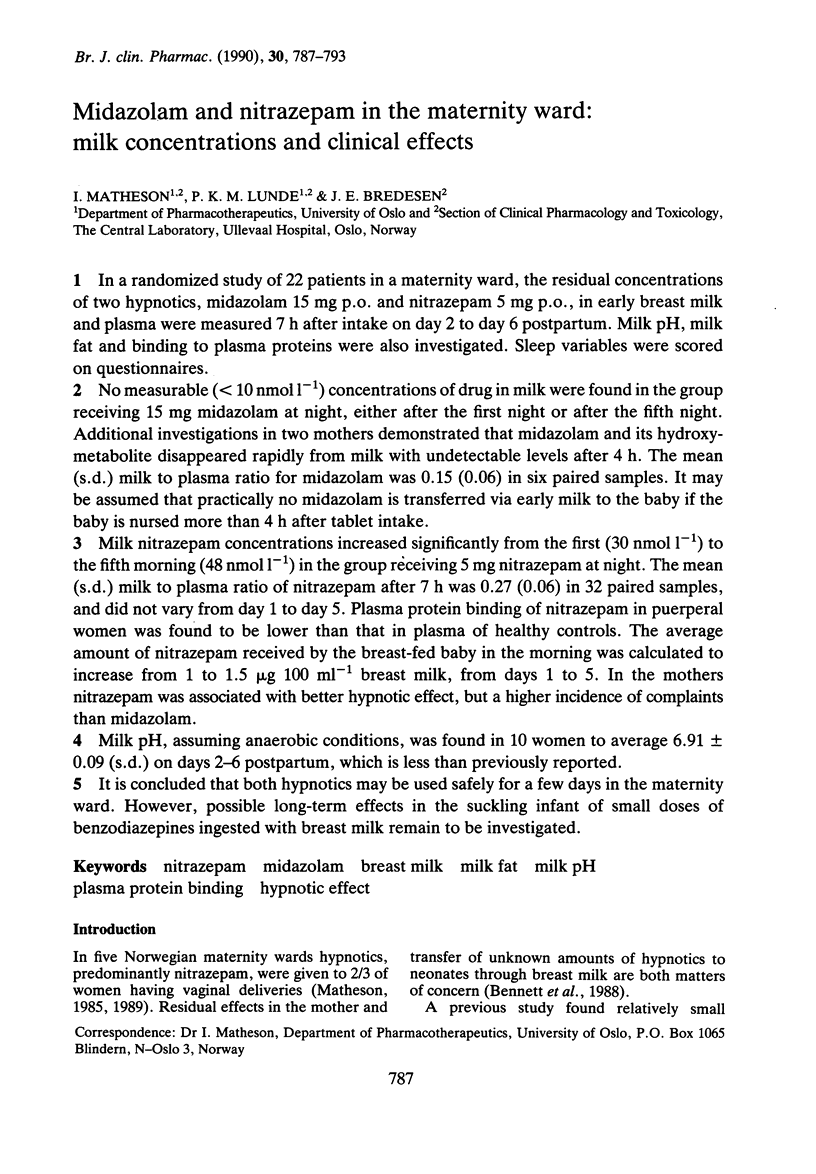
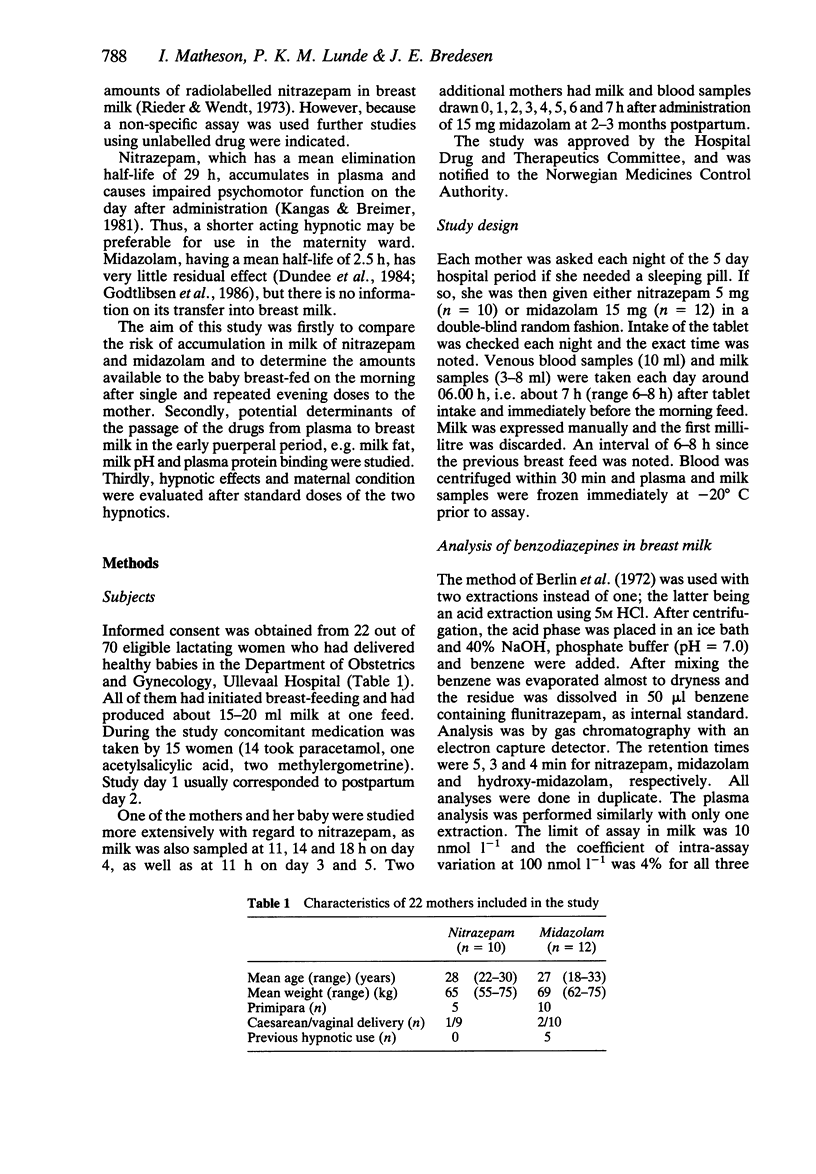
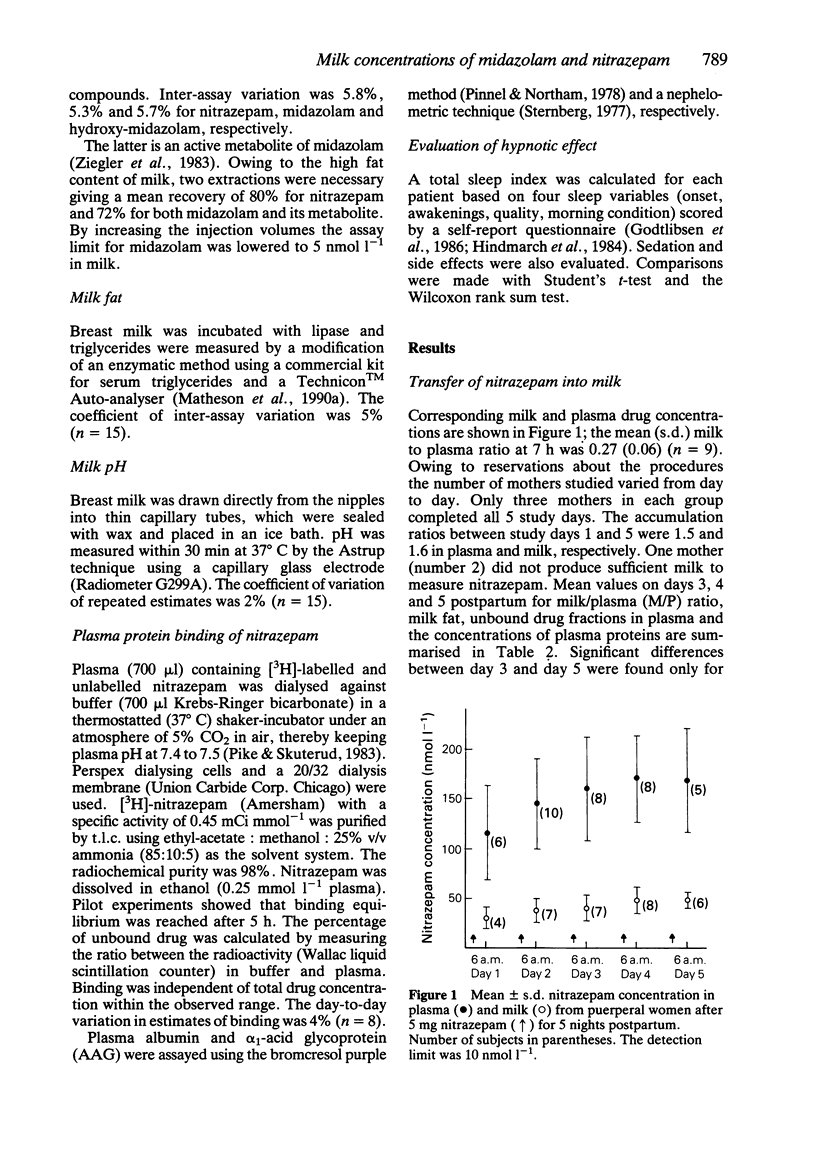
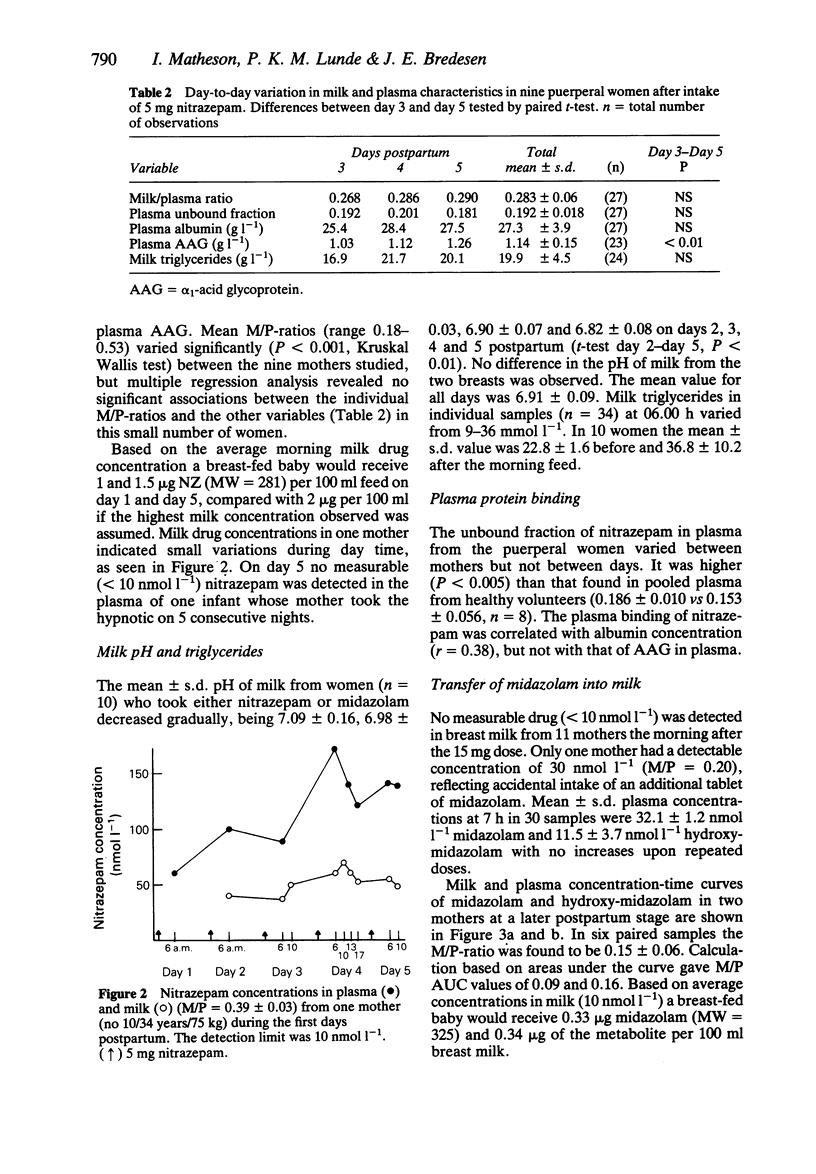
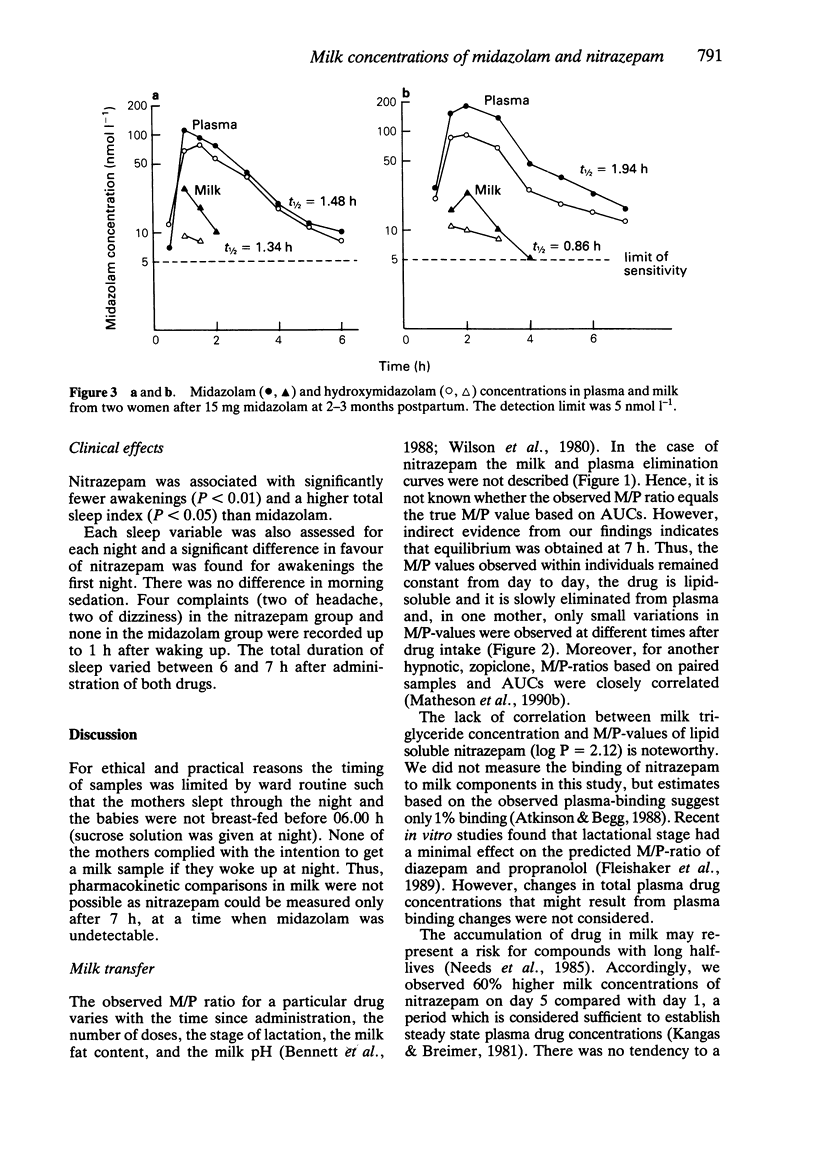
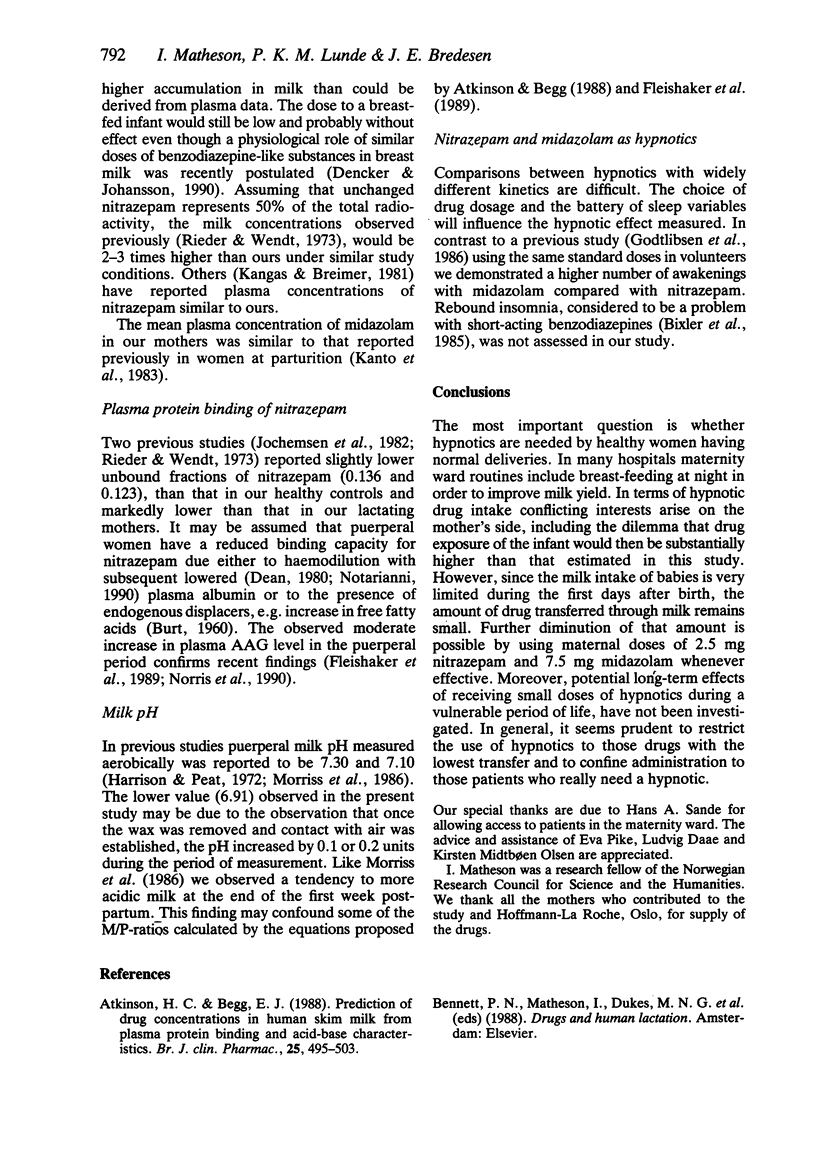
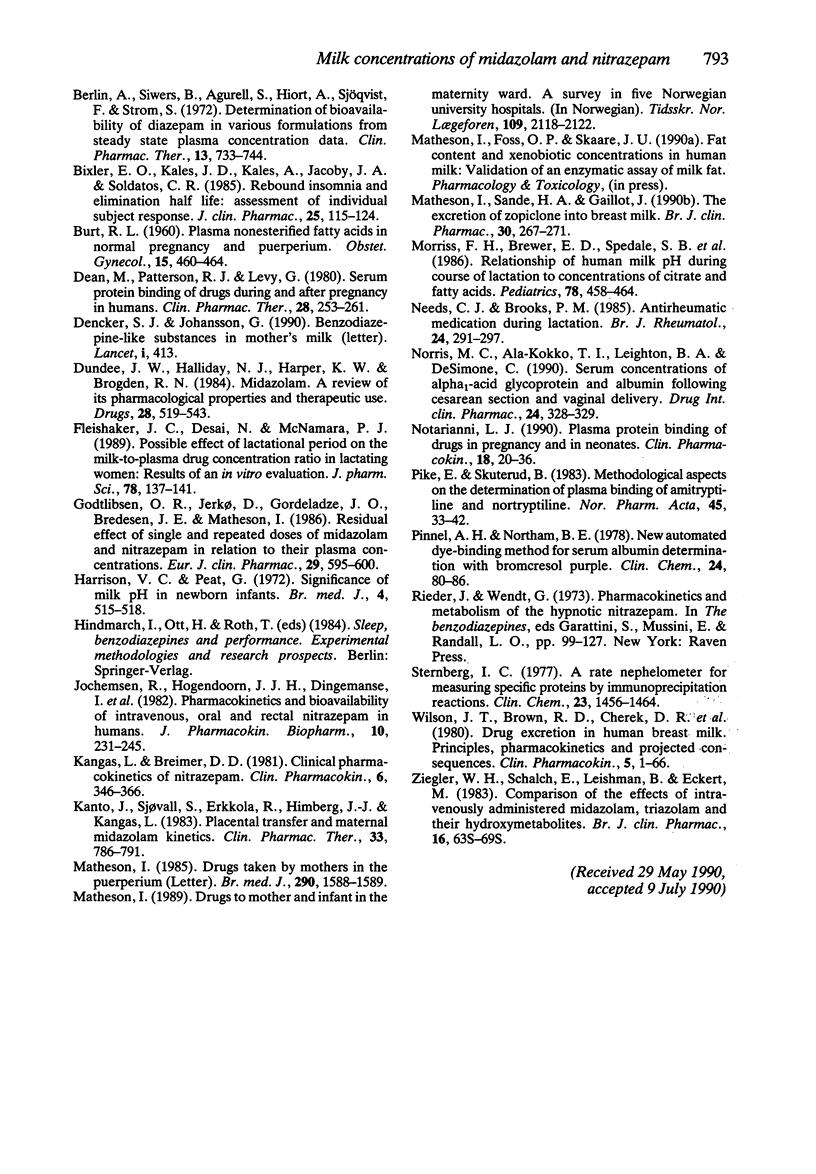
Selected References
These references are in PubMed. This may not be the complete list of references from this article.
- Atkinson H. C., Begg E. J. Prediction of drug concentrations in human skim milk from plasma protein binding and acid-base characteristics. Br J Clin Pharmacol. 1988 Apr;25(4):495–503. doi: 10.1111/j.1365-2125.1988.tb03334.x. [DOI] [PMC free article] [PubMed] [Google Scholar]
- BURT R. L. Plasma nonesterified fatty acids in normal pregnancy and the puerperium. Obstet Gynecol. 1960 Apr;15:460–464. [PubMed] [Google Scholar]
- Berlin A., Siwers B., Agurell S., Hiort A., Sjöqvist F., Ström S. Determination of bioavailability of diazepam in various formulations from steady state plasma concentration data. Clin Pharmacol Ther. 1972 Sep-Oct;13(5):733–744. doi: 10.1002/cpt1972135part1733. [DOI] [PubMed] [Google Scholar]
- Bixler E. O., Kales J. D., Kales A., Jacoby J. A., Soldatos C. R. Rebound insomnia and elimination half-life: assessment of individual subject response. J Clin Pharmacol. 1985 Mar;25(2):115–124. doi: 10.1002/j.1552-4604.1985.tb02811.x. [DOI] [PubMed] [Google Scholar]
- Dean M., Stock B., Patterson R. J., Levy G. Serum protein binding of drugs during and after pregnancy in humans. Clin Pharmacol Ther. 1980 Aug;28(2):253–261. doi: 10.1038/clpt.1980.158. [DOI] [PubMed] [Google Scholar]
- Dencker S. J., Johansson G. Benzodiazepine-like substances in mother's milk. Lancet. 1990 Feb 17;335(8686):413–413. doi: 10.1016/0140-6736(90)90246-2. [DOI] [PubMed] [Google Scholar]
- Dundee J. W., Halliday N. J., Harper K. W., Brogden R. N. Midazolam. A review of its pharmacological properties and therapeutic use. Drugs. 1984 Dec;28(6):519–543. doi: 10.2165/00003495-198428060-00002. [DOI] [PubMed] [Google Scholar]
- Fleishaker J. C., Desai N., McNamara P. J. Possible effect of lactational period on the milk-to-plasma drug concentration ratio in lactating women: results of an in vitro evaluation. J Pharm Sci. 1989 Feb;78(2):137–141. doi: 10.1002/jps.2600780213. [DOI] [PubMed] [Google Scholar]
- Godtilbsen O. B., Jerkø D., Gordeladze J. O., Bredesen J. E., Matheson I. Residual effect of single and repeated doses of midazolam and nitrazepam in relation to their plasma concentrations. Eur J Clin Pharmacol. 1986;29(5):595–600. doi: 10.1007/BF00635899. [DOI] [PubMed] [Google Scholar]
- Harrison V. C., Peat G. Significance of milk pH in newborn infants. Br Med J. 1972 Dec 2;4(5839):515–518. doi: 10.1136/bmj.4.5839.515. [DOI] [PMC free article] [PubMed] [Google Scholar]
- Jochemsen R., Hogendoorn J. J., Dingemanse J., Hermans J., Boeijinga J. K., Breimer D. D. Pharmacokinetics and bioavailability of intravenous, oral, and rectal nitrazepam in humans. J Pharmacokinet Biopharm. 1982 Jun;10(3):231–245. doi: 10.1007/BF01059259. [DOI] [PubMed] [Google Scholar]
- Kangas L., Breimer D. D. Clinical pharmacokinetics of nitrazepam. Clin Pharmacokinet. 1981 Sep-Oct;6(5):346–366. doi: 10.2165/00003088-198106050-00002. [DOI] [PubMed] [Google Scholar]
- Kanto J., Sjövall S., Erkkola R., Himberg J. J., Kangas L. Placental transfer and maternal midazolam kinetics. Clin Pharmacol Ther. 1983 Jun;33(6):786–791. doi: 10.1038/clpt.1983.107. [DOI] [PubMed] [Google Scholar]
- Larijani G. E., Norris M. C., Ala-Kokko T. I., Leighton B. A., DeSimone C. Serum concentration of alpha 1-acid glycoprotein and albumin following cesarean section and vaginal delivery. DICP. 1990 Mar;24(3):328–329. doi: 10.1177/106002809002400326. [DOI] [PubMed] [Google Scholar]
- Matheson I. Drugs taken by mothers in the puerperium. Br Med J (Clin Res Ed) 1985 May 25;290(6481):1588–1589. doi: 10.1136/bmj.290.6481.1588-a. [DOI] [PMC free article] [PubMed] [Google Scholar]
- Matheson I. Medikamenter til mor og barn i barselavdeling. En kartlegging ved fem norske universitetssykehus. Tidsskr Nor Laegeforen. 1989 Aug 10;109(22):2118–2122. [PubMed] [Google Scholar]
- Matheson I., Sande H. A., Gaillot J. The excretion of zopiclone into breast milk. Br J Clin Pharmacol. 1990 Aug;30(2):267–271. doi: 10.1111/j.1365-2125.1990.tb03774.x. [DOI] [PMC free article] [PubMed] [Google Scholar]
- Morriss F. H., Jr, Brewer E. D., Spedale S. B., Riddle L., Temple D. M., Caprioli R. M., West M. S. Relationship of human milk pH during course of lactation to concentrations of citrate and fatty acids. Pediatrics. 1986 Sep;78(3):458–464. [PubMed] [Google Scholar]
- Needs C. J., Brooks P. M. Antirheumatic medication during lactation. Br J Rheumatol. 1985 Aug;24(3):291–297. doi: 10.1093/rheumatology/24.3.291. [DOI] [PubMed] [Google Scholar]
- Notarianni L. J. Plasma protein binding of drugs in pregnancy and in neonates. Clin Pharmacokinet. 1990 Jan;18(1):20–36. doi: 10.2165/00003088-199018010-00002. [DOI] [PubMed] [Google Scholar]
- Pinnell A. E., Northam B. E. New automated dye-binding method for serum albumin determination with bromcresol purple. Clin Chem. 1978 Jan;24(1):80–86. [PubMed] [Google Scholar]
- Sternberg J. C. A rate nephelometer for measuring specific proteins by immunoprecipitin reactions. Clin Chem. 1977 Aug;23(8):1456–1464. [PubMed] [Google Scholar]
- Wilson J. T., Brown R. D., Cherek D. R., Dailey J. W., Hilman B., Jobe P. C., Manno B. R., Manno J. E., Redetzki H. M., Stewart J. J. Drug excretion in human breast milk: principles, pharmacokinetics and projected consequences. Clin Pharmacokinet. 1980 Jan-Feb;5(1):1–66. doi: 10.2165/00003088-198005010-00001. [DOI] [PubMed] [Google Scholar]
- Ziegler W. H., Schalch E., Leishman B., Eckert M. Comparison of the effects of intravenously administered midazolam, triazolam and their hydroxy metabolites. Br J Clin Pharmacol. 1983;16 (Suppl 1):63S–69S. doi: 10.1111/j.1365-2125.1983.tb02272.x. [DOI] [PMC free article] [PubMed] [Google Scholar]


